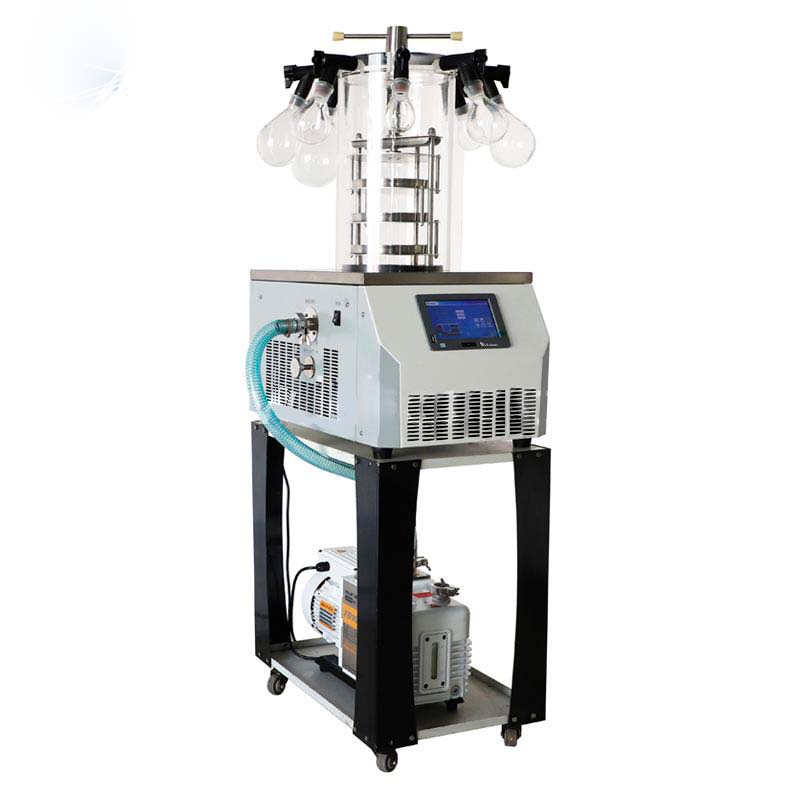Freeze-dryers are laboratory equipment designed to perform dehydro-freezing or cryodessiccation processes, by separating water or other solvents, without changing the qualitative or quantitative composition of the product. They are particularly used to preserve a temporary food or to make the material more suitable for transport.
Therefore, freeze-dryers are used for the preservation of food and biological materials such as: cells, tissues, bacteria and vaccines by transforming them into dry products, avoiding decomposition and enzymatic, biological and chemical changes.
Freeze dryer functions
Freeze-drying is the mechanism of drying products, becoming the best organic and inorganic method, without changing its composition. It is carried out by vacuum and at low temperature and thus avoid the denaturation of proteins.
This team performs the cryodrying processes and is composed of three components:
- Dry or freeze-drying chamber with hermetic closure: the product is frozen beforehand and then passed through solid steam.
- Condenser in which a cooling circuit is included: it compresses the steam process and communicates with the dry chamber.
- A vacuum system: by means of the oil pump, the original air is separated from the dry chamber when the freeze-drying course is formed, helping in the sublimation process.
Thus, freeze-drying processes are based on the physical change of the dissipation of water or an organic separator of frozen aqueous-organic mixture; this separator or solvent sublimates directly to steam without passing through the liquid state. Usually, when working with food, protein or biological material, the solvent to be removed is converted to water.
Types of freeze dryers
We have freeze-dryers that are used in the food industry, whether it is to make space food, military food, dairy products or dehydrated food. In addition, there are various teams applied for the pharmaceutical sector, towards the conservation of vaccines and medicines.
Similarly, there are freeze dryers that are used in the performance of water damaged documents, these are grouped by size into laboratory units, for the progress and increase of processes and devices of larger production size. Similarly, freeze dryers can also be classified by the type of product chamber:
- Freeze-dryers in which the product is usually pre-frozen and in vials,
- Freeze dryers with shelves in which the product is placed on a tray or directly on a shelf.
- Freeze dryers with units preparing with both drying options.
Lyophilization Procedures
For laboratories, samples of small quantities, round tubes capable of withstanding the closures inside the freeze dryers are used, and at the industrial level trays are used. For the realization of the processes of cryodessiccation of samples are made by the following steps:
- Freezing the sample at low temperature: freeze-drying of products directly affects the appearance and quality of the final product. The sample is usually introduced in liquid nitrogen (-196°C) or in a bath of dry ice and acetone (-78°C) until complete freezing.
- Drying of the frozen product by sublimation: the sample is introduced into the containers of the sublimation chamber, closing the keys of each one, opening ours, and when it has arrived under vacuum, opening all the others.
Finally, the freeze-drying process must be performed in reverse to break the vacuum of the sample with great care, letting air in slowly. If this is not done, the solid sample may be turbulent and scattered on the walls of the chamber. The key is then closed, disconnected from the chamber, the vial is removed, and the cap is closed again to prevent moisture.
Kalstein freeze dryers
We at Kalstein offer you the best technology of laboratory equipment, and the freeze dryers are ideal for drying processes of any sample. These belong to the YR series, feature CFC-free cooling, LCD screen drying curves, English interface. Large condenser opening, condenser with pre-freezing function.
In addition, they have many other attractive features, which you can enjoy our catalog from HERE

